How to Calculate Workforce Productivity? Formulas & Best Practices
Table of Contents
- What is Workforce Productivity?
- Why Bother Measuring Workplace Productivity?
- Different Types Of Productivity
- The Math Behind Productivity
- Your Step-by-Step Productivity Calculation Guide
- ProHance Features for Remote Work Productivity Tracking
- Build a Culture That Embraces Measurement
- Frequently Asked Questions
Picture this: your team seems busy all day, but somehow, projects drag on forever. Sound familiar? You’re not alone. Most office workers are actually productive for just 2 hours and 23 minutes each day. That’s a problem, but it’s also an opportunity.
Getting a handle on workforce productivity isn’t just about counting hours anymore. With remote work changing everything and business moving faster than ever, knowing how to measure what really matters has become absolutely essential.
What is Workforce Productivity?
Think of productivity as getting the most return on your investment – except instead of money, you’re looking at time, effort, and resources. But here’s where it gets interesting. Workplace productivity isn’t just about churning out more widgets per hour. Sure, that matters, but today’s productivity also includes things like solving complex problems, coming up with innovative solutions, and working well with others.
The remote work shift has really shaken things up, too. Companies are realizing that watching someone sit at their desk doesn’t tell you much about how productive they actually are. Actual output matters more than hours logged – a lesson many organizations learned the hard way during the pandemic.
Why Bother Measuring Workplace Productivity?
Here’s something that might surprise you: nonfarm business labor productivity jumped 1.4 percent from the first quarter of 2024 to early 2025. Companies that track these numbers aren’t just satisfying their curiosity – they’re getting real competitive advantages.
When you measure productivity properly, you stop guessing and start knowing. Which teams are doing better? Where are the bottlenecks? What changes actually make a difference? The data tells the story. This becomes even more crucial when you consider that global employee engagement dropped to just 21% in 2024. That’s a lot of disengaged workers, and without proper measurement, you might not even realize the problem exists in your organization. This significant drop in engagement cost the global economy $438 billion in lost productivity.
Different Types Of Productivity
Below is the overview of four major types of workforce productivity:
Labor Productivity – The Classic
This one’s straightforward: how much output do you get per hour of work? It’s the most common productivity metric. Take your total output, divide it by the total hours worked, and you’ve got your baseline number.
Revenue Productivity – Show Me the Money
Revenue productivity cuts straight to what matters most for many businesses: how much money each employee generates. This metric helps you understand which roles and departments are really driving financial results.
Task Productivity – Getting Granular
Sometimes, you need to zoom in on specific activities. How quickly are support tickets getting resolved? How many code reviews are completed per week? Task productivity gives you the detailed view you need for process improvements.
Capital Productivity – Return on Investment
Don’t forget about your equipment, software, and other investments. Capital productivity measures how well your non-human resources are performing. That expensive new software platform better be delivering results.
The Math Behind Productivity
The Foundation Formula
Everything starts with this simple equation: Productivity = Output ÷ Input
Seems basic, right? But this foundation supports everything else:
- Customer service tickets resolved per hour
- Sales revenue per employee
- Manufacturing units per shift
- Marketing leads generated per campaign
Labor Productivity Deep Dive
Labor Productivity = Total Output ÷ Total Labor Hours
Let’s say your development team shipped 20 features in 800 hours. That’s 0.025 features per hour, or one feature every 40 hours. It’s not the most inspiring way to think about it, but it’s incredibly useful for planning and resource allocation.
Revenue Per Employee
Revenue Productivity = Total Revenue ÷ Number of Employees
This number tells you a lot about your business model and operational efficiency. A $10 million company with 50 employees has very different productivity dynamics than one with 200 employees.
The Efficiency Check
Efficiency Ratio = (Actual Output ÷ Expected Output) × 100
This percentage shows how well you’re hitting your targets. Consistently running at 110% efficiency? Maybe it’s time to raise your goals. Stuck at 75%? Time to investigate what’s going wrong.
The Comprehensive View
Multi-Factor Productivity = Output ÷ (Labor + Capital + Materials)
When you really want to understand your operation, this formula considers everything you’re putting in. It’s more complex to calculate but gives you the complete picture of organizational efficiency.
Your Step-by-Step Productivity Calculation Guide
Start with the Why
Before diving into spreadsheets and formulas, nail down exactly what you’re trying to achieve. Are you looking to improve team performance? Justify a budget request? Identify training needs. Your objective shapes everything else.
Pick Your Metrics Wisely
Not all metrics are created equal. Choose ones that actually connect to your business goals and give you actionable insights. Measuring email response time might be interesting, but does it really matter for your bottom line?
Build Your Baseline
You can’t improve what you don’t measure, and you can’t measure improvement without knowing where you started. Collect at least a few weeks of historical data before making any changes.
Set Up Your Systems
Consistency is everything in productivity measurement. Whether you’re using spreadsheets, specialized software, or a combination of tools, make sure your data collection process is reliable and repeatable.
Crunch the Numbers
Apply your chosen formulas to the data you’ve collected. But don’t stop at the math – look for patterns, trends, and surprises in the results.
Act on What You Learn
Data without action is just expensive trivia. Use your productivity calculations to make real changes in how work gets done.
ProHance Features for Remote Work Productivity Tracking
| Feature | What It Does | Why Remote Teams Love It |
| Time Tracking | Captures work time automatically across applications and websites | No more manual timesheets – Get accurate data without manual logging in and out |
| Activity Analytics | Analyzes work patterns in real-time and scores productivity | Discover when team members do their best work and plan accordingly |
| Project Management | Tracks tasks, deadlines, and project progress | Keep distributed teams aligned with clear visibility into who’s doing what |
| Performance Dashboards | Creates customizable reports with key performance indicators | Give managers the remote team overview they need without micromanaging |
| Resource Optimization | Balances workloads and plans team capacity | Prevent burnout by distributing work fairly across remote team members |
| Wellness Monitoring | Tracks breaks and sends burnout prevention alerts | Keep remote employees healthy and engaged for long-term productivity |
Build a Culture That Embraces Measurement
The most sophisticated productivity calculations won’t help if your team sees measurement as punishment rather than improvement. Successful organizations create cultures where productivity tracking is viewed as a tool for growth and development.
The future of productivity measurement will likely include more sophisticated metrics that capture things like innovation, collaboration effectiveness, and long-term value creation.
The key will be maintaining the human edge in increasingly automated measurement systems. Technology should enhance human judgment, not replace it.
Frequently Asked Questions
How often should organizations recalculate productivity metrics?
Most companies find monthly comprehensive reviews with weekly progress checks work well. Critical projects might need daily monitoring, while long-term strategic initiatives could be reviewed quarterly. The key is matching measurement frequency to decision-making needs.
Can productivity be measured for creative roles?
Absolutely, though it requires different approaches. Creative productivity might include project completion rates, client satisfaction scores, innovation metrics, or peer collaboration effectiveness. The trick is identifying meaningful output indicators that align with creative objectives.
What role does employee satisfaction play in productivity calculations?
Employee satisfaction significantly impacts productivity outcomes. Satisfied employees typically show higher engagement, better quality work, and improved collaboration. Many organizations track satisfaction as a leading indicator of future productivity trends.





